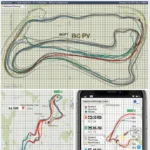OBD2 scanners have revolutionized car diagnostics, empowering both DIYers and professionals to pinpoint vehicle issues efficiently. These compact devices offer a window into your car’s computer system, revealing valuable data about its performance and health. This guide will delve into the world of OBD2 scanners, exploring their functionalities, benefits, and various types available on the market.
Understanding the Basics of OBD2 Scanners
OBD2, short for On-Board Diagnostics II, is a standardized system implemented in most vehicles manufactured after 1996. It provides a common communication protocol for accessing diagnostic trouble codes (DTCs) and other valuable vehicle data. OBD2 scanners serve as the interface between your car’s computer and you, translating complex data into understandable information. They can reveal a range of issues, from minor sensor malfunctions to more serious engine problems. Having an OBD2 scanner can save you time and money on costly repairs by identifying problems early on. You can check our guide about Harbor Freight OBD2 scanners.
What exactly are the benefits of owning an OBD2 scanner?
- Early problem detection: Identify issues before they become major headaches.
- Cost savings: Avoid unnecessary trips to the mechanic for simple diagnostics.
- Improved vehicle maintenance: Monitor your car’s health and address issues proactively.
- Enhanced understanding of your vehicle: Gain insights into your car’s performance and functionality.
- Empowerment: Take control of your car’s maintenance and repairs.
Different Types of OBD2 Scanners: Choosing the Right One
Navigating the market of OBD2 scanners can seem daunting with the variety of options available. Each type caters to different needs and budgets. Let’s explore the main categories:
Basic Code Readers
These entry-level scanners are perfect for retrieving and clearing basic DTCs. They are affordable and user-friendly, suitable for DIY enthusiasts who want to perform basic diagnostics. These scanners provide the code and a brief description of the issue, allowing you to understand the problem at a surface level.
Advanced Code Readers
A step up from basic code readers, these scanners offer more advanced features, such as live data streaming, freeze frame data, and the ability to view multiple parameters simultaneously. They provide a deeper insight into your car’s performance and are ideal for those who want more comprehensive diagnostic capabilities. These scanners allow you to monitor sensor readings in real time, giving you a dynamic view of your vehicle’s operation.
Professional Scan Tools
Used by professional mechanics and technicians, these high-end scanners offer comprehensive diagnostic capabilities, including bi-directional control, advanced coding functions, and access to manufacturer-specific data. They are an investment, but essential for those who perform complex diagnostics and repairs. For those interested in GoTech OBD2 scanners, check out this GoTech OBD2 resource.
How to Use an OBD2 Scanner
Using an OBD2 scanner is typically straightforward. Locate your car’s OBD2 port, usually under the dashboard on the driver’s side. Plug the scanner in, turn the ignition on (but don’t start the engine), and follow the prompts on the scanner’s screen. Most scanners will automatically detect the vehicle’s protocol and begin retrieving DTCs.
“A reliable OBD2 scanner is an indispensable tool for any car owner, allowing them to take proactive steps in maintaining their vehicle’s health and performance,” says John Miller, a seasoned automotive technician with over 20 years of experience.
Finding Deeply Discounted OBD2 Scanners
While professional-grade scanners come with a higher price tag, there are options for those on a budget. Look for deals and discounts on reputable online retailers or consider purchasing a used scanner from a trusted source. Just be sure to verify its functionality and compatibility with your vehicle before making a purchase. For those looking for a specific type of scanner, such as a USB KKL OBD2, check our dedicated page on USB KKL OBD2.
Conclusion
OBD2 scanners are powerful tools that can provide valuable insights into your vehicle’s health. By understanding the different types of scanners and their functionalities, you can choose the right one for your needs and budget. Investing in an OBD2 scanner is an investment in your car’s longevity and your peace of mind.
FAQs
- Are all OBD2 scanners compatible with all cars? Most scanners are compatible with vehicles manufactured after 1996 in the US, but always check compatibility before purchasing.
- What does a “pending code” mean? A pending code indicates a potential issue that hasn’t yet occurred frequently enough to trigger a permanent DTC.
- Can I clear codes with an OBD2 scanner? Yes, most scanners allow you to clear DTCs. However, clearing codes doesn’t fix the underlying problem.
- What is live data streaming? Live data streaming displays real-time sensor readings, allowing you to monitor your car’s performance dynamically.
- Do I need a professional scanner for DIY repairs? Not necessarily. Basic and advanced code readers are often sufficient for many DIY tasks.
- Where can I find reliable information about OBD2 codes? Reputable online resources and automotive forums can provide valuable information about DTCs.
- What if my car was manufactured before 1996? Pre-1996 vehicles may use different diagnostic systems, and you’ll need to research the appropriate scanner for your specific make and model.
Common OBD2 Scanner Situations
- Check Engine Light is on: This is the most common reason people use OBD2 scanners. The scanner can pinpoint the cause of the warning light.
- Car is running rough: An OBD2 scanner can identify misfires, fuel system issues, or other problems affecting engine performance.
- Decreased fuel economy: The scanner can detect issues with oxygen sensors, fuel injectors, or other components that impact fuel efficiency.
- Emissions testing failure: An OBD2 scanner can help diagnose the problem before retesting.
Further Resources
For further information about OBD2 scanners, visit our website and explore our articles on various topics, including obd2 診断 機.
For support, contact us via WhatsApp: +1(641)206-8880, Email: [email protected] or visit our office at 789 Elm Street, San Francisco, CA 94102, USA. Our customer service team is available 24/7.


